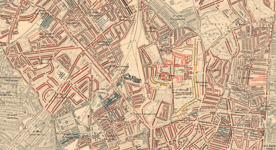14 December 2016
|
The lives of late 19th-century Londoners can be explored on a website which uses poverty maps and police notebooks to detail street-by-street disparities of wealth and poverty in the city.
The lives of late 19th-century Londoners can be explored on a website which uses poverty maps and police notebooks to detail street-by-street disparities of wealth and poverty in the city. For the latest family history news, views and features, sign up to our free e-newsletter.
Charles Booth's Inquiry Into the Life and Labour of the People in London was a path-breaking investigation into the social conditions faced by Londoners living in the late-Victorian era. To mark the 2016 centenary of Booth’s death, the London School of Economics & Political Science (LSE) has relaunched the website dedicated to Booth’s life and work as Charles Booth's London.
Booth’s poverty maps were pioneering in the use of colour to detail the street-by-street disparities of wealth and poverty in London. The maps were drawn from a series of “police notebooks” that Booth and his team produced by walking the streets of the Victorian metropolis. The newly redeveloped website makes available both the police notebooks and the poverty maps.

HOW TO USE THE SITE
- The poverty maps are available as a single interactive version using modern online mapping techniques, and are also available individually for download. The interactive version of the map allows users to search by location, and offers the ability to geo-locate individual notebooks according to the streets Booth and his team walked when doing their research.
- The police notebooks are available to browse and search, can be read using state-of-the-art manuscript viewer technology, and are available for download.
In addition to making available the maps and notebooks, the site also includes contextual information about Booth’s life and times and about the Inquiry, and provides a series of highlights offering a “way in” to the rich archival material.
A 'PIONEERING STUDY'
Nicola Wright, Director of LSE Library said: “This was a pioneering study and I am thrilled to see this important archive reinvented again and made even more engaging and accessible. The innovative work of the LSE Library team and our partners is a fitting tribute to Booth’s great endeavour.”
In July 2016 the Booth archive was inscribed on UNESCO's Memory of the World Register, which recognises culturally significant heritage material from across the UK, joining other material such as the Bill of Rights and the Magna Carta. The redeveloped website reflects LSE’s ongoing commitment to make available LSE Library’s collections as widely as possible and via new and innovative means.
Visit the website.
(Maps show from top: inner southern district; northern district)








.jpg)